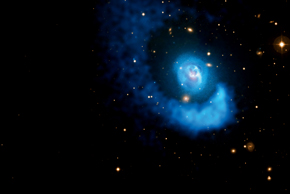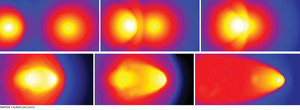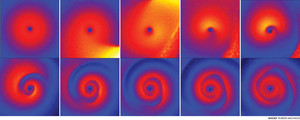
NASA/CXC/BU/E. BLANTON; ESO /VLTGas spiral in Abell 2052… NASA/CXC/BU/E. BLANTON; ESO /VLT
Galaxy clusters can resemble a glass filled with wine—at least to the experienced eye of an astrophysicist, as evidenced in the most recent scientific paper by Gastão Lima Neto, a galaxy cluster expert at the University of São Paulo (USP), and his colleague Rubens Machado, a post-doctoral grant recipient and expert in computerized astronomical simulation. Any connoisseur knows that, in order to better appreciate the aromas of a good wine, you need to swirl the glass around in a circular motion before bringing it to your nose. And he also knows that if the motion is too forceful, the waves generated on the surface of the liquid—which help release the wine’s bouquet into the air—can build enough to slosh out of the glass.
Astronomical observations have suggested that a phenomenon very similar to the sloshing of a liquid caused by the circular motion of its container may have occurred on a cosmic scale billions of years ago in the Abell 2052 galaxy cluster. Some of the gas that had accumulated in the center of this group of hundreds of galaxies 480 million light-years from Earth is thought to have been agitated until it gushed toward the periphery of the cluster, creating a spiral-shaped tail of gas that extends for more than 800,000 light-years through the vast expanse of space between the galaxies (about eight times the length of the Milky Way, the galaxy where our Sun resides). A study conducted by Machado and Lima Neto, with findings to be published in the March 2015 issue of Monthly Notices of the Royal Astronomical Society, is the first to use computer simulations to explain this sloshing of gas into the spiral observed in the Abell 2052 cluster. “Researchers have hypothesized this mechanism, but no one had done calculations to confirm it,” Machado says.
The new simulations suggest that about two billion years ago, a small group of a few dozen galaxies, traveling through space at 1,000 kilometers per second, crossed the periphery of the Abell 2052 cluster, some six million light-years from its center. The small traveling group was then attracted by the gravitational force of the larger cluster, and its galaxies began to rotate around the center of Abell 2052. But, as dictated by the laws of movement, every action has a reaction. According to Machado, the movement of the small group around the cluster agitated the center of Abell 2052. “The gravitational disturbance caused by the small group pulled the cluster from side to side,” he explains. “The gas that had been motionless in the center of the cluster began to oscillate and eventually sloshed outward.”
Machado and Lima Neto compared the results of their simulations with images of galaxies near the cluster and were able to identify another group of galaxies on its periphery that may very well have been the cause of the sloshing. These galaxies have the same position and total mass as the group that, according to the simulations, is thought to have stirred up Abell 2052 two billion years ago.
The small cluster of galaxies has a total mass 10 trillion times greater than the mass of the Sun (10 trillion kilograms). The total mass of the Abell 2052 cluster is 100 times greater: a thousand trillion solar masses. More startling, however, is the fact that all of the hundreds of galaxies in the cluster, each having billions of stars, add up to only 3% of the total mass of the cluster. “Curiously, the galaxies are only a detail of the clusters—a detail that we can even confidently ignore in the simulations,” Machado says.
The mass of the galaxy clusters is primarily (82%) what is known as dark matter, the nature of which is still not fully understood by physicists. The remaining 15% of their mass is in the form of normal gas found throughout the vast expanse of millions of light-years between the galaxies. The gas consists primarily of ionized hydrogen atoms. Although it is very rarefied, it is hotter than the core of the Sun and emits high-energy X-rays that are captured here on Earth by space telescopes. Lima Neto compares the observation of this hot gas with a medical X-ray image. By observing where there are more or fewer X-rays within a galaxy cluster, it is possible to do an analysis of its history, as in the case of the spiral of X-rays observed by the Chandra telescope in the Abell 2052 cluster.
The cluster gets its name from the so-called Abell Catalog, a list of over 4,000 galaxy clusters that American astronomer George Abell began to compile in 1958. Today, astronomers know that these groups of hundreds to thousands of galaxies were formed through the amalgamation of smaller clusters that collide with one another over the course of billions of years. “Few clusters have been observed during the act of colliding,” Machado explains. “Even so, many clusters show signs of having collided; the objective of the simulations is to reconstruct how they got that way.”

In a simulated head-on collision, the smaller cluster passes into the larger one reproducing the X-ray tail (in yellow)…
Spectacular collision
Rubens Machado and Lima Neto decided to do research on Abell 2052 after they successfully simulated an even more spectacular collision, which gave rise to the Abell 3376 cluster. With a mass and size similar to those of Abell 2052, 3376 is 614 million light-years from the Earth. Lima Neto was part of an international team of astronomers that published observations of Abell 3376 in the journal Science in 2006. They proved that electrons in the space around the cluster emit radio waves, because of the energy they gain from shock waves generated by the collision between two smaller clusters that merged to form a larger one. In that same article, the astronomers showed that the hot, X-ray-emitting gas within the Abell 3376 cluster is concentrated in an arc-shaped region resembling a comet.
Simulations that the two researchers published in Monthly Notices of the Royal Astronomical Society in 2013 suggest that Abell 3376 is the product of a collision between two clusters that occurred half a billion years ago. A major cluster was hit head-on by a smaller one, about one-sixth the mass of the present-day Abell 3376. The smaller cluster penetrated the larger one and is still passing through it today, at a speed of 2,600 kilometers per second. Machado explains that this speed is four times greater than the speed of sound in the cluster gas. The supersonic speed of the collision caused the comet-like arc observed in 2006.
For the study of Abell 3376, Machado analyzed more than 200 simulations, each one reconstructing three billion years of the history of the cluster in a different way. It took 12 hours to calculate each simulation. A single ordinary computer would take 16 years to complete the study. It was completed in only three months, however, by using the Alphacrucis, a computer cluster consisting of 2,304 processors installed at the USP Institute of Astronomy, Geophysics and Atmospheric Sciences (IAG-USP) in 2012 (see Pesquisa FAPESP Issue No. 193).
The main difficulty of computer-simulating the force of gravity of dark matter and hot gas in clusters is that the loss of energy through X-ray emission destroys part of the information about the history of the cluster. “There is no mathematical criterion for exploring all the possible scenarios,” Machado explains. “We hypothesized detailed, physically plausible histories, but we have no way of guaranteeing that the solutions found are the only ones.”
“That is the weak point of the simulations,” remarks astronomer Renato Dupke of the National Observatory in Rio de Janeiro, who observes collisions between galaxy clusters. He notes that what can be seen currently is a projection of the cluster in the sky. “It’s the two-dimensional projection of a three-dimensional object, which makes it difficult to know what is happening in the line of sight. Moreover, some properties of the cluster are measured indirectly. Consequently, there can be several solutions for the same problem, and a subsequent analysis is needed in order to pick the best one.”
That is what Lima Neto and Machado did in January 2014 when they observed the Abell 3376 cluster with the Blanco Telescope at the Cerro Tololo Inter-American Observatory, in Chile. The data from their observations have not yet been analyzed, but it is their hope that the distribution of dark matter in the cluster, which is still unknown, will match the prediction from their simulations. “We’re hopeful,” Machado says. “In any case, we’re going to publish a new paper on the subject soon.”
Scientific article
MACHADO, R. E. G. and LIMA NETO, G. L. Simulations of gas sloshing in galaxy cluster Abell 2052. Monthly Notices of the Royal Astronomical Society. V. 447 (3). Mar. 2015.

